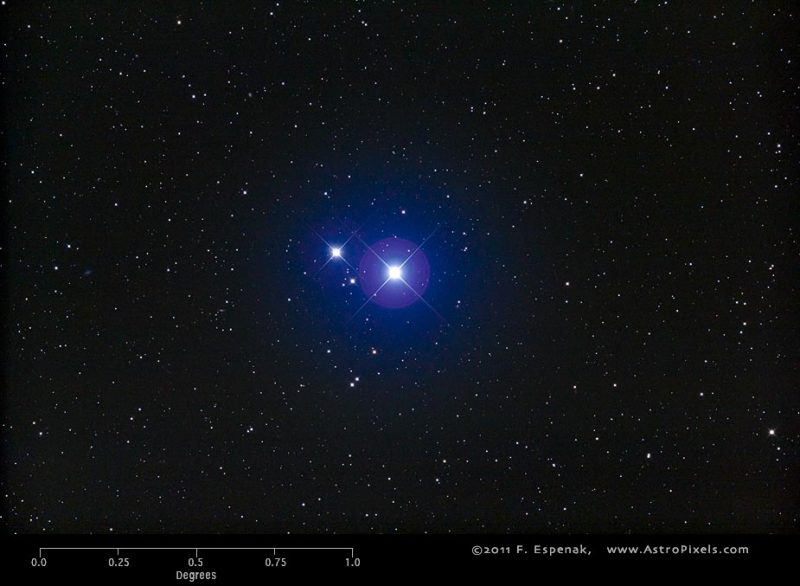
Mizar and Alcor
Mizar and its fainter companion star Alcor make up one of the most famous double stars in the sky. These two stars are bound to one another by gravity. And they’re located in the famous Big Dipper, an asterism which is ascending in the northeast on February and March evenings. You can spot this pair easily, and it’s lots of fun to see them! Look at the middle star in the Dipper’s handle. You’ll spot Mizar first, because it’s brighter. Look closely, and you’ll see fainter Alcor right next to Mizar.
Historically, Mizar and Alcor are a test of eyesight. But even people with less-than-perfect eyesight can see the two stars, especially if they’re looking in a dark, clear sky. This pair of stars in the Big Dipper’s handle has the nickname of horse and rider. If you can’t see fainter Alcor with the unaided eye, use binoculars to see Mizar’s nearby companion.

Mizar alone is a quadruple star
Mizar is perhaps the Big Dipper’s most famous star, glorified in the annals of astronomy many times over. Apart from Alcor, Mizar by itself is a double star. In fact, it was the first double star known. An Italian astronomer brought it to the attention of Galileo in 1617. A third Italian astronomer, Giovanni Battista Riccioli, wrote about Mizar as a double star.
Few, if any, astronomers back then even dreamed that double stars were anything other than chance alignments of physically unrelated stars. Yet, in 1889, a spectroscope revealed that the brighter component of Mizar’s two stars consisted of two stars itself. This made Mizar the first binary star ever discovered by spectroscopic means.
Later, Mizar’s dimmer telescopic component also showed itself to be a spectroscopic binary, meaning that Mizar consists of two sets of binaries, making it a quadruple star.

And Alcor is double
As for Alcor, scientists long believed that Mizar and Alcor were not gravitationally bound and did not form a true binary star system. Not until 2009 did our knowledge expand. Two groups of astronomers independently reported that Alcor is itself a binary, consisting of Alcor A and Alcor B. Astronomers now believe that the Alcor binary system is gravitationally bound to the Mizar quadruple system. That makes this “double” star six stars in all, but we can only see two with the unaided eye.
Mizar and Alcor have proven to not only be a test of human eyesight, but a test of the limits of our technological vision as well.

Bottom line: Famous star pair Mizar and Alcor is easy to find in the handle of the Big Dipper. Mizar is really four stars, and Alcor is two stars. So what we see as two stars are really six in one!
The post Mizar and Alcor in the bend of the Big Dipper first appeared on EarthSky.
from EarthSky https://ift.tt/2YQgUjK

Mizar and Alcor
Mizar and its fainter companion star Alcor make up one of the most famous double stars in the sky. These two stars are bound to one another by gravity. And they’re located in the famous Big Dipper, an asterism which is ascending in the northeast on February and March evenings. You can spot this pair easily, and it’s lots of fun to see them! Look at the middle star in the Dipper’s handle. You’ll spot Mizar first, because it’s brighter. Look closely, and you’ll see fainter Alcor right next to Mizar.
Historically, Mizar and Alcor are a test of eyesight. But even people with less-than-perfect eyesight can see the two stars, especially if they’re looking in a dark, clear sky. This pair of stars in the Big Dipper’s handle has the nickname of horse and rider. If you can’t see fainter Alcor with the unaided eye, use binoculars to see Mizar’s nearby companion.

Mizar alone is a quadruple star
Mizar is perhaps the Big Dipper’s most famous star, glorified in the annals of astronomy many times over. Apart from Alcor, Mizar by itself is a double star. In fact, it was the first double star known. An Italian astronomer brought it to the attention of Galileo in 1617. A third Italian astronomer, Giovanni Battista Riccioli, wrote about Mizar as a double star.
Few, if any, astronomers back then even dreamed that double stars were anything other than chance alignments of physically unrelated stars. Yet, in 1889, a spectroscope revealed that the brighter component of Mizar’s two stars consisted of two stars itself. This made Mizar the first binary star ever discovered by spectroscopic means.
Later, Mizar’s dimmer telescopic component also showed itself to be a spectroscopic binary, meaning that Mizar consists of two sets of binaries, making it a quadruple star.

And Alcor is double
As for Alcor, scientists long believed that Mizar and Alcor were not gravitationally bound and did not form a true binary star system. Not until 2009 did our knowledge expand. Two groups of astronomers independently reported that Alcor is itself a binary, consisting of Alcor A and Alcor B. Astronomers now believe that the Alcor binary system is gravitationally bound to the Mizar quadruple system. That makes this “double” star six stars in all, but we can only see two with the unaided eye.
Mizar and Alcor have proven to not only be a test of human eyesight, but a test of the limits of our technological vision as well.

Bottom line: Famous star pair Mizar and Alcor is easy to find in the handle of the Big Dipper. Mizar is really four stars, and Alcor is two stars. So what we see as two stars are really six in one!
The post Mizar and Alcor in the bend of the Big Dipper first appeared on EarthSky.
from EarthSky https://ift.tt/2YQgUjK

Aucun commentaire:
Enregistrer un commentaire